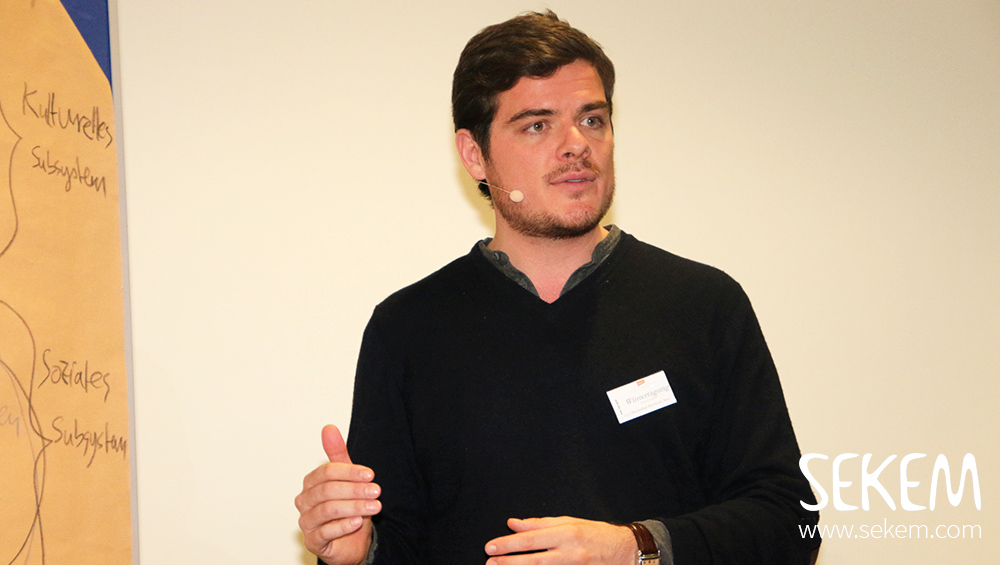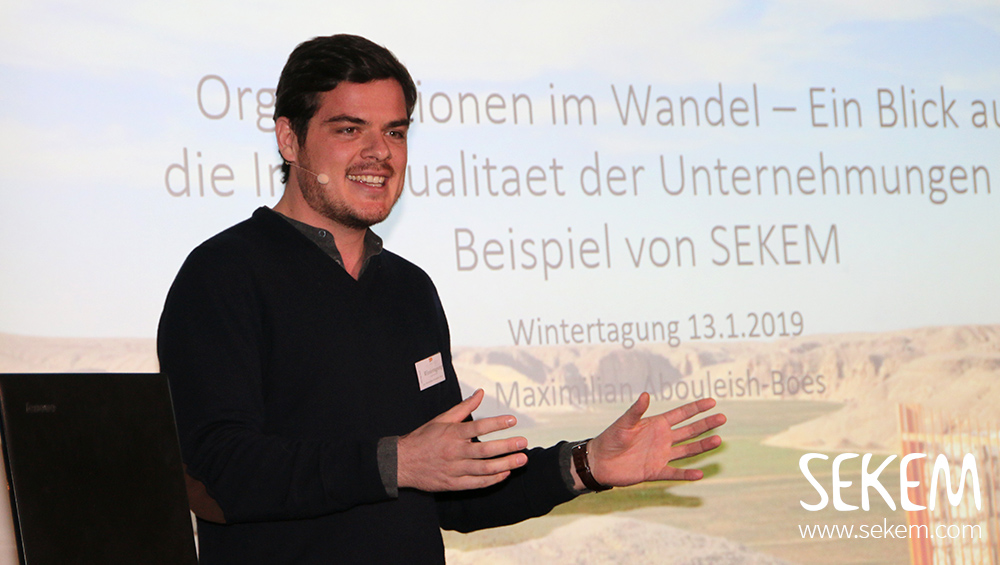In the framework of the Winter Conference of the Farmers Society/Demeter in the North, which took place at Landgut Stemmen in Northern Germany from 12 to 13 January, SEKEM member Maximilian Abouleish-Boes reported on SEKEM as an organization in transition. The main thoughts of his lecture he summarized in the following essay.
The world is changing
During theses days, there are crises all over the world. News are full of it and sometimes I wonder how long this will continue. Whether in Germany, Egypt or elsewhere: we face systemic social and environmental challenges that today’s political and economic systems is not able to deal with – actually because these systems have created the problems themselves. As we can observe in history or in nature, it requires a higher systemic logic, in regard to humans a next level of consciousness in order to achieve a change or rather transformation and deal with the complexity of the problems. The society needs social innovations!
Biodynamic agriculture, as described by Rudolf Steiner in the Agricultural Course, is not just an ecological, but also such a social innovation. The design of the farm organism is guided by the human – this kind of agriculture sees itself as a self-contained system that is similar to humans and that can contribute to the sustainable development of the earth. Diversity is a central element of the farm organism and includes the harmonious interaction of minerals, plants and animals that humans organize. It is also crucial how the farm organism is embedded in the value chain, from the farm to the consumer.
Associative economy through new forms of organization
In the prevailing economic systems that dominate the global world, profit maximization in free competition is the core – the stronger one wins. This principle is in contrary to many elements of the Biodynamic movement, questioning the diversity of a farm organism or taking time to produce a deep connection between man, nature and the cosmos. The Demeter brand demand is increasing, but the speed and the associated price wars are not in line with the idea of an associative economy. Associative economy basically means that all participants in the value chain receive sufficient value from the value created in order to develop freely – physically, emotionally and mentally.
SEKEM is a development impulse that already embodies many elements of associative economy. Farms as well as processing and refining businesses are under one roof and centrally managed. This has the advantage that profits can be fairly distributed, even though the price pressure from the customers for instance is clearly noticeable. In times of crisis, the strong parts of the value chain can help out the weak. A picture of a living organism emerges.
Frederic Laloux, a Belgian organizational consultant and development researcher, demonstrated in his book Reinventing Organizations that human consciousness development is accompanied by new organizational forms. There are many patterns in the history of mankind of how people organize themselves – from circulating gangs, to tribal cultures, from state apparatuses and bureaucratic organizations, to global corporations or value communities. The fact, however, is that in the past centuries a hierarchical model is the predominant organizational form in the world. But the question arises whether this form of organization can still respond adequately to the existing challenges and deal with the complexity of the world? The problem with hierarchical organizations is that the power of decision-making is very centralized and often pervaded by the patterns of power of a dominant patriarchy. The pressure to adapt at the periphery of the organization can often not be met quickly enough. The American management guru Peter Drucker expressed it like this: “Today more organizations than ever die of digestive problems and not of starvation”. There is a generally recognized lack of agile structures and flexible adaptation. But Laloux also says that new forms of organization are in the making all over the world.
New forms of organization emerge
Laloux describes three breakthroughs of organizational forms corresponding to the new integral age: holistic view of man, self-organization, and the evolutionary purpose of the organization.
The holistic view of the human being in this context means reducing a person not only to the work or the image of a payee but to perceive people in their entirety for instance by responding to their character traits and personalities. Behind this, stands the conviction that only people who are intrinsically motivated and feel integrated into a community with their strengths and weaknesses are able to do a good job.
Self-organization aims to give full responsibility to people for their respective areas and to promote self-initiative. Decisions can therefore be made where they are really relevant. This, of course, means at the same time that the central power must be given up and the hierarchical responsibility needs to be decentralized.
These two breakthroughs can create a field of development for the organization in which the purpose of the organization itself changes. This is due to the fact that people with their strengths and interests contribute to the organization and take responsibility for performances that open up new fields of action for the organization as a whole. The focus on the purpose also makes clear that people are no longer just a brand or a company name, but see the meaning and purpose of their work as an orientation for their work.
“. . . to enable each individual to make an intelligent contribution to the bigger picture.”
This development path was already considered a few decades ago by Bernard Lievegoed and later also by Friedrich Glasl. It illustrates a process that describes the organization as a transforming entity that evolves from the pioneering phase, through the phase of differentiation, to the integral phase, and can ultimately arrive in an association phase. It shows a kind of maturing of the nature of the organization that follows similar principles as we can observe in nature. Various elements of the organization go through maturation processes and a next phase arises from the growing pains of the previous phase. This describes the kind of social innovation that was mentioned at in the beginning and that enables an organization to handle increasingly complex challenges. What Laloux describes as a new form of organization can thus be equated with the integral phase of an enterprise whose goal is to enable each individual to make an intelligent contribution to the larger picture. Although we are certainly still far away from that in SEKEM and in the whole world, it should not prevent us from practising.
This points to the central challenge of the consciousness development of all participants, who shape and work for a living organism as a whole. Leadership gets a new quality and the integral phase is the necessary prerequisite for different organizations to come together in associations along a value chain. Forming an integral phase within an organization can also, in my view, be seen as a form of training, as this can only be realized by profound changes in behavior and consciousness.
Leading with the question
In the integration phase, the focus lies on the expansion of the cultural subsystem of the organization – vision, identity or strategy must not belong exclusively to the top executives but are collectively supported by the employees. This allows the existing social subsystem (the pioneer phase) and the technical-instrumental subsystem (the differentiation phase) to reach a different level of synergy, which is why it is referred to as the “integration phase”. This can only be achieved if a kind of entrepreneurial spirit is supported and arises from all employees who are aligned with the organizational goals.
This is currently difficult to imagine, given the different levels of consciousness of the workers, who for the most part demand strong leadership and direction from authority. Or is it more the executives, who are not accustomed to give up power through their socialization and experience and are not able to lead rather through questions than answers?
The call for personal responsibility
In my experience, the call for ownership and entrepreneurship do not necessarily need to involve a high level of complexity, but rather inspire the initiative within the person to take responsibility for something, to master challenges, no matter how small they appear. Instead of a vertical orientation, a horizontal orientation becomes dominant. This means that employees focus on external or internal customers and suppliers as well as the process rather than on the manager. A common interest must be developed in order to maintain an optimal workflow within the guidelines, principles and general planning framework. The constant renewal of products, markets, structures or processes shapes an organization that becomes a learning system.

Finally, deep human development must ensure that new responsibilities are constantly transferred to changing situations. It should be the goal that individuals and groups are to a certain extent responsible for parts of the planning. As a result, there should be no set regulations, but commitments that leave space for initiative and participation.
The described elements of the integral phase are not yet lived reality at SEKEM because the top management determines the procedure. A development towards a living organism as a model of the integral phase can only be achieved if the mentality of the current leadership and the workforce of SEKEM changes fundamentally. In order to achieve the integration of the cultural, technical-instrumental and social subsystems, a new organizational structure is needed that differs significantly from the previous two phases.
The pioneering phase is characterized by a flat, broad organizational structure led by a heroic and visionary leader. The differentiation phase forms a deep, pyramidal shape with constituent and controlling guidance. And the third phase calls for the concept of a “process organization”. The task of the top management must be to create goals for the entire system and to integrate the necessary tools for process flows and a fast information system. The leadership style towards middle and lower management shifts from the previous style of leadership and control to encouraging people to ask questions, make judgments, and take initiative. A healthy interpersonal relationship and a culture of feedback and trust are indispensable.
Greening interpersonal relationships
To form this new culture of cooperation and to create a fertile ground for the development of the social system within the organization requires a conscious interaction with each other. Often people fall into the classic dynamics of victims, perpetrators and rescuers who try to blame each other for their responsibility. This creates a low drama that results in accusation and disappointment, driven by the fear of identity loss of each individual’s ego. The goal to be strived for between people who want to serve a common purpose starts with being fully accountable and dealing honestly with their feelings. Feelings can be used as a positive incentive to change and solve problems. But most people are not used to that and often there is an impression of a social desert around us, wherein people feel left alone. Sometimes, people are afraid to express their honest opinions, which may be crucial to the evolution of the organization.
As part of a new generation, I would like to call for the greening of human relationships and to recall that there are many parallels between the social system of an organization and the quality of the soil of our agriculture. The healthier the social relationships, the better the individual potentials of the people can develop. Maybe, trust, sincerity and courage are the social preparations we need for the (bio)dynamic change of our organizations.
Maximilian Abouleish-Boes
Pictures Copyright: Bäuerliche Gesellschaft e.V./Demeter im Norden
The Future Doesn’t Fall from Heaven
Embracing Social Innovation: Transformation Within and Beyond Organizations

